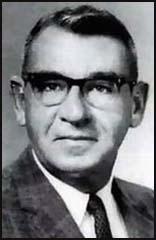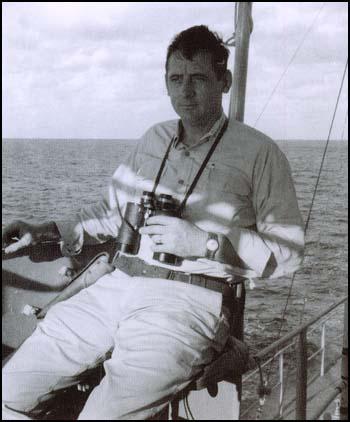Rip Robertson

William (Rip) Robertson was born in Texas. He joined the United States Marines and served in the Pacific during the Second World War.
After the war Robertson joined the Central Intelligence Agency. He was employed as a counter-intelligence agent and was involved in what became known as Executive Action (a plan to remove unfriendly foreign leaders from power). This including a coup d'état that overthrew the Guatemalan government of Jacobo Arbenz in 1954 after he introduced land reforms and nationalized the United Fruit Company.
Robertson became a CIA outcast after he was found responsible for ordering the bombing of a British ship which he had mistakenly identified as Russian. He moved to Nicaragua where he worked as an adviser to the government of Anastasio Somoza.
Robertson returned to the CIA before the Bay of Pigs operation. He commanded the supply ship Barbara J and disobeyed orders by landing in Cuba with Brigade 2506. Afterwards Roberson became a member of staff at CIA's JM WAVE station in Miami.
In the winter of 1962 Eddie Bayo claimed that two officers in the Red Army based in Cuba wanted to defect to the United States. Bayo added that these men wanted to pass on details about atomic warheads and missiles that were still in Cuba despite the agreement that followed the Cuban Missile Crisis.

Bayo had originally fought with Fidel Castro against Fulgencio Batista. He disagreed with Castro's policies after he gained power and moved to Miami and helped establish Alpha 66. His story was eventually taken up by several members of the anti-Castro community. William Pawley became convinced that it was vitally important to help get these Soviet officers out of Cuba. To help this happen he contacted James Eastland, the chairman of the Senate Internal Security Subcommittee.
William Pawley also contacted Ted Shackley, head of the CIA's JM WAVE station in Miami. Shackley decided to help Pawley organize what became known as Operation Tilt. He also assigned Robertson to help with the operation. David Sanchez Morales, another CIA agent, also became involved in this attempt to bring out these two Soviet officers.
In June, 1963, a small group, including Robertson, John Martino, William Pawley, Eddie Bayo and Richard Billings, a journalist working for Life Magazine, secretly arrived in Cuba. They were unsuccessful in their attempts to find these Soviet officers and they were forced to return to Miami. Bayo remained behind and it was rumoured that he had been captured and executed. However, his death was never reported in the Cuban press.
during the John F. Kennedy motorcade in Dallas on 22nd November, 1963?
Some researchers such as James Richards have argued that photographic evidence suggests that Robertson was in Dealey Plaza during the assassination of John F. Kennedy. Others involved in the plot include James Arthur Lewis, Roy Hargraves, Edwin Collins, Steve Wilson, Gerry P. Hemming, David Morales, Herminio Diaz Garcia, Tony Cuesta, Eugenio Martinez, Virgilio Gonzalez and Felipe Vidal Santiago.
Robertson was later sent to Vietnam. He died in 1970 from the after effects of malaria.
Primary Sources
(1) Bradley E. Ayers, letter to John R. Tunheim (23rd August, 1994)
I make reference to your letter of February 23d and my subsequent communications with your staff in preparation for our meeting which is scheduled for 10.00 CDT this morning. I appreciate the opportunity to visit with you concerning matters relating to the assassination of President Kennedy and your appointment as a member of the board that will oversee the release of documents pertaining thereto.
Over the past several months I have furnished your staff with details of my background and other materials which I trust have provided you with some perspective for the information I hope to personally convey. Assuming you have read or been briefed on the essence of this history, I will not dwell upon it here. However, I take this opportunity to convey copies of two documents which I recently received that relate directly to our discussion of this date. They are self-explanatory.
With the context of our meeting hopefully established, I wish to call your attention to the following specifics which I urge you and the Board to be alert for and to pursue within the framework of your mandate. These areas of interest and individual identifications are recommended as adf.rect result of my experience with the CIA/JMWAVE Miami station during the period immediately preceding and following the death of JFK and my synthesis of other information developed since that experience.
I believe the following living individuals have intimate operational knowledge of the circumstances surrounding the assassination and the possible role of the persons and/or operations listed in the paragraph which follows:
Theodore Shackley - Chief of Station, JMWAVE Robert Wall - Deputy Chief of Operations, JMWAVE
Grayson Lynch - Contract paramilitary trainer/agent, JMWAVE
Felix Rodriguez - Contract paramilitary agent (Cuban born), JMWAVE
Thomas Clines - CIA paramilitary case officer, JMWAVE
Above named persons with reference to:
Gordon Campbell (current status unknown) - Deputy Chief of Station, JMWAVE
David Morales (deceased) - Chief of Operations, JMWAVE
"Rip" Robertson (deceased) - Contract paramilitary agent JMWAVE
Edward Roderick (current status unknown) - U. S. Army Major, explosives expert/Corp of Engineers, attached to JMWAVE and later CIA employee upon retirement from Army
Tony Sforza (deceased) - Contract paramilitary agent, JMWAVE
Operation (code name) "Red Cross" - JMWAVE, Fall 1963
Further, I invite your attention to the forthcoming issue of Vanity Fair Magazine (October issue) which I am advised will contain an article by Tony Summers, a highly credible journalist/author (CONSPIRACY) that will offer certain revelations complimenting the recommendations made in this communication.
I know for a fact that Summers has been diligently pursuing lines of inquiry that may be relevant to the work of the Board and may be useful in unscrambling and evaluating the JFK related documents produced by the CIA and other government agencies.
I hope the information I've provided is helpful to the Board and I remain prepared to testify under oath to any aspect of my activities should that be desired.
(2) Christopher Barger, memorandum to Jeremy Gunn (18th May, 1995)
I interviewed former US Army captain and CIA employee Bradley Ayers on May 12, 1995, at Ayers' home in Woodbury, Minnesota. The interview lasted from 10.00 a.m. to 3.00 p.m. The following is a summary and report of the interview...
Q. Did Morales ever try and pass himself off as Cuban?
A. Not to Ayers' knowledge, but "he could easily pass for Cuban." Morales was allegedly a very good actor, and "could pull off lots of roles." Here the conversation drifted into a discussion of David Morales and his emotional makeup. Ayers charged that Morales was a "mean" man who "paraded around the station like a tyrant." Everyone was apparently afraid of him. Morales hung with what Ayers called the "circle" - Morales, Roselli, Tony Sforza, Manuel Artime and Rip Robertson. The four were drinking buddies and of like mind on politics. Ayers said they were vicious, too. "If anyone put together a sniper team to hit the President, Morales, Rip, Rosselli and Sforza would have done it." Ayers noted that Artime, Robertson, Rosselli and Sforza all died just as the HSCA began investigating. He suggests checking for Morales' whereabouts during the late seventies, especially on the times these men were killed.

